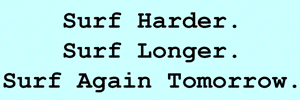[sam_pro id=”1_45″ codes=”true”]








 ‘When you surf, your brain is going haywire, but in a coordinated fashion. Specifically, dozens of maps in your brain are coding the position of the wave and the positions of the surfers around you. Appealing to all surfers, identifying these maps requires is what’s referred to as the traveling wave technique.
‘When you surf, your brain is going haywire, but in a coordinated fashion. Specifically, dozens of maps in your brain are coding the position of the wave and the positions of the surfers around you. Appealing to all surfers, identifying these maps requires is what’s referred to as the traveling wave technique.Without one particular area, area MT (more about MT later), your life as a surfer would be nearly impossible because it codes for different directions of motion.
Attention affects memory. If you do not specifically attend to particular things, it’s as if you didn’t see them at all. So, to read waves better, attend to the details of the waves and how they move, and you will begin to see details that you haven’t noticed before (probably because you were too busy talking in the lineup and annoying everyone else).
Some people read waves better than others. Think Kelly Slater in the dying minutes of a heat or that dude who always seems to find the hole to poke through at your local beach break. Some of this ability comes with experience of course, but without certain brain structures, none of us would be able to see what a wave is doing or update in real-time what it’s going to do next.
That being said, let’s talk about what the brain is doing as we perceive how a wave is moving. Consider the image of Mick Fanning flying down the line at Snapper in the images below. His visual system is bombarded by all types of visual motion as his eyes dart around to ensure that he gets the best ride possible. His eyes and brain work together to do this fast and efficiently. But, millisecond precision does not mean simple. Millions of brain cells, or neurons, are working together to ensure that Fanning – and you – get the best ride that you can. And here’s how…
Figure 1: Top left: Mick Fanning in the barrel in a crowded Snapper line-up.
Top right: Same image, but with a schematic of the coordinate system that the retina and visual cortex use to interpret our visual world. Red indicates Fanning’s direction of gaze and the orange spot indicates the center of where he is looking. The colors in the schematic match the colors on the brain images in the bottom row. Both the visual angle (blue) and the eccentricity (or distance from the center; white) are systematically mapped on the retina and in dozens of areas in the human brain.
Bottom left: Medial view of an example brain (dotted line indicates zoomed portion at right). The dark gray pixels are indentations  of the cortex (think valleys) and are typically hidden from view because the brain is folded up. The light gray pixels are gyri (think peaks).
of the cortex (think valleys) and are typically hidden from view because the brain is folded up. The light gray pixels are gyri (think peaks).
Bottom middle: As Fanning stares at the surfer’s head, this image is represented in multiple maps in visual cortex. One such map is shown here, where the red colors indicate those that are representing the surfer’s head. The dark blue colors represent the lip of the wave.
Bottom right: In addition to an eccentricity map, there is also an additional map of visual angle. So, the lip of the wave is also represented in the red/purple band in this image. The take home point is that the visual system represents our visual world in a series of multiple maps distributed throughout the brain. Appealing to all surfers, the scientific methodology used to map these areas delineated in the bottom row is referred to as the traveling wave technique (Brain images modified from Wandell et al., 2007; see suggested reading for further details).
The visual input of the wave enters the eye as photons of light. These photons hit photoreceptors in the back of our retinas and are transformed into electrical impulses. These electrical signals are then sent through the optic nerve to subcortical (that is, under the cortex) structures before reaching visual cortex located at the back of our heads. An amazing feature of the relationship betwe en the retina and visual cortex is that the world that we see is preserved in retinotopic coordinates within areas of the brain. What this means in surfing terms is that when Fanning stares at the surfer heading over the wave as he flies down the line, two adjacent points of that surfer are mapped to two adjacent points on the retina, and then to two adjacent points in visual cortex. As Fanning’s eyes dart around to survey what the wave is doing while keeping track of all the surfers in the way, the map of retinotopic coordinates is updated and his perception of this ocean scene is also updated in real time by the brain. And then updated again. And then again – again and again in multiple maps distributed in a processing hierarchy.
en the retina and visual cortex is that the world that we see is preserved in retinotopic coordinates within areas of the brain. What this means in surfing terms is that when Fanning stares at the surfer heading over the wave as he flies down the line, two adjacent points of that surfer are mapped to two adjacent points on the retina, and then to two adjacent points in visual cortex. As Fanning’s eyes dart around to survey what the wave is doing while keeping track of all the surfers in the way, the map of retinotopic coordinates is updated and his perception of this ocean scene is also updated in real time by the brain. And then updated again. And then again – again and again in multiple maps distributed in a processing hierarchy.
The more complicated the image features, the higher in the hierarchy it is processed. For example, angles of lines are processed early in the hierarchy and the entire image of Fanning in a Snapper barrel is processed late in the hierarchy. One particular brain area is critical for our accurate perception of the direction that the wave – and even that the other surfers in the water – are moving. This brain region is referred to as area MT and is located in the middle of this visual hierarchy.
This brain area is fascinating! In addition to the maps of eccentricity and visual angle as described in the prior section, it also contains columns that separately code for different directions of motion within this piece of cortical tissue. So, as Fanning travels down the line, area MT is informing other parts of his brain – particularly pre-motor and motor-cortex – about the subtle ways in which the water is moving in order for his motor cortex to correctly time the turns that he is going to do. An interesting feature of area MT is that without it, we wouldn’t be able to see water – or anything frankly – move. Consequently, we wouldn’t be able to surf.
What does this mean? People without area MT are what is called ‘motion-blind’ or they have akinetopsia. They would be able to see Fanning watching the waves as he stood on the shoreline to time his paddle out (as long as he wasn’t moving). But, as soon as he started walking, it would be as if he didn’t exist. Even though MT is located in the middle of the visual hierarchy, often considered as the fifth visual area, it takes less than 50 milliseconds for neural signals to reach MT! This is because there are routes in the brain that bypass intervening areas in order for neural signals to reach MT very quickly. Consequently, area MT is crucial in our ability for both reading waves and for accurately paddling and negotiating the line-up as it contributes to split-section reaction times. It is important to note that it’s not the only area of the brain contributing to how we perceive motion, but it is widely considered as one of the most important.
So, while this might be a high-level crash course in how the visual cortex helps us read waves and how one region in particular, area MT, contributes more than others, what does this also mean for people who can’t see? You might remember Derek Rabelo, the blind surfer who surfed Pipe. How can he read waves and perceive motion if he can’t see the water moving? The fact of the matter is, as long as the cortical tissue is healthy in visual cortex, these structures get recruited to ‘see’ with his other senses. No cortex goes to waste if the brain can help it. Through his experience in the water, the brain slowly re-wires itself to use these areas – including MT – to guide his perception of visual motion even though his eyes cannot guide him. For example, recent research shows that area MT in blind subjects subsumes the role of auditory, as opposed to visual, motion perception. Additionally, what does this mean for you to make you a better surfer? Attention affects memory and affects you as you move through the water. If you do not specifically attend to particular things, it’s as if you didn’t see them at all. So, to read waves better, attend to the details of the waves and how they move, and you will begin to see details that you haven’t noticed before – the shifts in the rips, how the wind affects the crumble on top of the lip, etc. For us surfers, and for your brain, attending to details matters to make you a better surfer.
 Together, we just tackled some important brain organization that gives us the gift of reading waves. The truth is, everything we do is a result of complex computations performed by complicated neural circuits. I hope to explain some of these neural circuits to you in the context of surfing in the next series of articles because without our brains, we wouldn’t be able to move our feet, let alone walk on water.’
Together, we just tackled some important brain organization that gives us the gift of reading waves. The truth is, everything we do is a result of complex computations performed by complicated neural circuits. I hope to explain some of these neural circuits to you in the context of surfing in the next series of articles because without our brains, we wouldn’t be able to move our feet, let alone walk on water.’
Suggested Reading:
Albright, T.D., Desimone, R., & Gross, C.G. (1984). Columnar organization of directionally-selective cells in visual area MT of the macaque. Journal of Neurophysiology 51(1): 16-30.
Rauschecker, A.M., Dastjerdi, M., Weiner, K.S., Witthoft, N., Nasrullah, S., Chen, J.,
Selimbeyoglu, A., & Parvizi, J. (2011). Illusions of Visual Motion Elicited by Electrical
Stimulation of Human Area MT+, PLoS One, 6(7):e21798.
Salzman, C.D., Britten, K.H., Newsome, W.T. (1990). Cortical microstimulation influences perceptual judgments of motion direction. Nature 346: 174-177.
Wandell, B.A., Dumoulin, S.O., and Brewer, A.A. (2007). Visual Field Maps in Human Cortex. Neuron 56: 366-383 Zeki, S. (2004). Thirty years of a very special visual area, Area V5. The Journal of Physiology, 557(1), 1–2.









